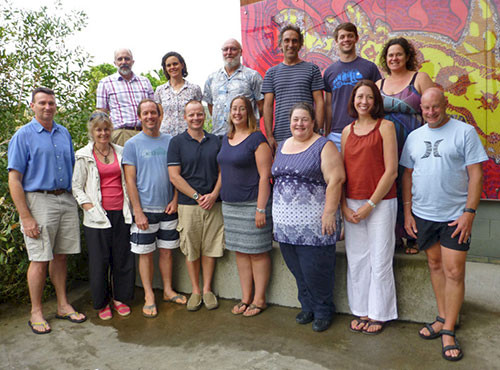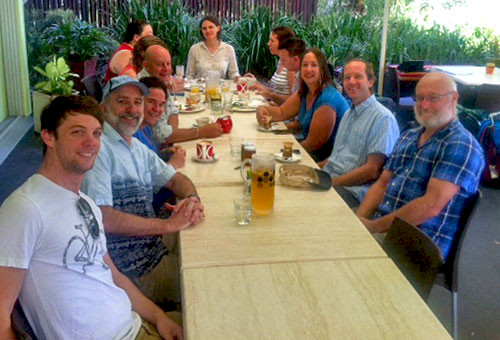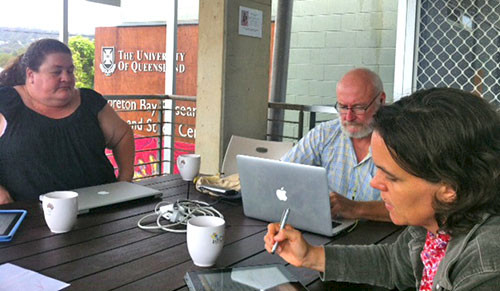Australian Centre for Ecological Analysis and Synthesis workshop: "Australian seagrass habitats: Condition and threats"
Bill Dennison ·I participated in a week long seagrass working group meeting at the Moreton Bay Research Station on North Stradbroke Island. The working group meeting was sponsored by the Australian Centre for Ecological Analysis and Synthesis (ACEAS) modeled after the U.S.-based National Center for Ecological Analysis and Synthesis (NCEAS). ACEAS is run by Associate Professor Alison Specht and is part of the Terrestrial Ecosystem Research Network (TERN), chaired by Professor Andrew Campbell. I attended the TERN annual meeting in Melbourne in 2011, so it was nice to be involved with one of their working groups. I missed the initial working group meeting in 2012 due to a wonky gall bladder, but was quickly brought up to speed by my colleagues.

The Principal Investigator for the seagrass working group was James Udy from Healthy Waterways in Brisbane. James had collected a dozen seagrass researchers from all over Australia, and I had worked with all but one previously. Participants included Peter Scanes and Angus Richardson from New South Wales Department of Environment and Climate Change, Gary Kendrick from The University of Western Australia and Kieryn Kilminster from Western Australia Department of Water, Kathryn McMahon from Edith Cowan University, Michelle Waycott from the University of Adelaide, Lynda Radke from Geoscience Australia, Kate O'Brien and Mitch Lyons from the University of Queensland, Paul Maxwell from Griffith University, Len McKenzie from James Cook University, Jonathan Hodge from CSIRO, and Vanessa Lucieer from the University of Tasmania (Vanessa the the only person I had not worked with before). In addition to bringing geographic diversity, the participants brought a diversity of scientific skills and resource management perspectives were well represented.

We worked on two seagrass papers which have a theme of seagrass resilience; one led by Kate O'Brien and the other by Kathryn MaMahon. It was both a productive and enjoyable workshop. We decided that the workshop had the five 'S' secrets to success: Sleeping with ocean breezes (at a nice resort along Home Beach), Swimming in the ocean (which we did every morning at 7 am), Seagrass discussions at the research station (which had great views of One Mile Harbour), Swilling beer at the Straddie Pub (with its great views of Moreton Island), and Singing silly seagrass songs.

There are three major reasons why the Australian seagrass researchers and managers have a unique global perspective on these ecosystems. 1) The species diversity of both temperate and tropical seagrass assemblages in Australia is high, and the total species richness of Australian seagrasses is over half of the global species richness. 2) There are two extensive reefal systems along the Australian coast which provide extensive protected seagrass habitats. One reefal system is the Great Barrier Reef, extending for 2,000 km along the Northeast coast (Carruthers et al., 2002). The other, lesser known reefal system extends along the Southwest coast for 2,500 km from Shark Bay to the Great Australian Bight (Carruthers et al., 2007). This Southwest Australian reefal system is comprised of a series of offshore limestone reefs. The extent of these reefal systems is globally unique, serving to enhance the extent and biomass of seagrasses. These reefal systems also contribute to the diversity of life history and morphology traits of Australian seagrasses, which encompass the global diversity of seagrass life histories and morphologies. 3) The presence of large populations of seagrass megaherbivores (dugong and green sea turtles) in tropical waters is globally unique to Australian waters. Tropical seagrasses co-evolved with this grazing pressure, yet in most areas of the world, only remnant populations of mega herbivores remain (e.g., Caribbean, Indo-Pacific islands). Thus, the natural ecosystem dynamics which include grazing pressure across the tropical seascape can only be observed and investigated in Australian waters.

In addition to catching up with old friends, snorkeling on the One Mile Harbour seagrass meadows and visiting with our friends Kevin and Kath Townsend at the research station, it was wonderful to be immersed in seagrass research and management again. I look forward to the publications that are produced from this workshop.
References
Carruthers TJB, Dennison WC, Kendrick GA, Waycott M, Walker DI, Cambridge ML (2007) Seagrasses of south-west Australia: A conceptual synthesis of the world's most diverse and extensive seagrass meadows. JEMBE 350:21–45
Carruthers TJB, Dennison WC, Longstaff BJ, Waycott M, Abal EG, McKenzie LJ, Long WJL (2002) Seagrass habitats of northeast Australia: Models of key processes and controls. Bulletin of Marine Science 71(3):1153–1169
About the author
Bill Dennison

Dr. Bill Dennison is a Professor of Marine Science and Interim President at the University of Maryland Center for Environmental Science (UMCES).